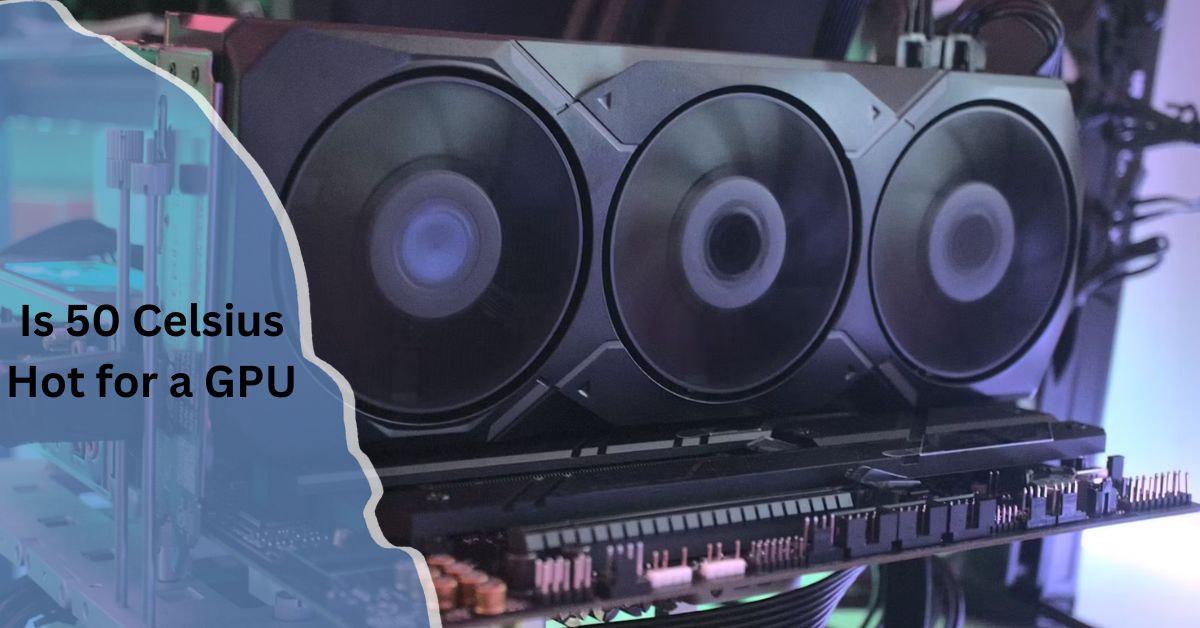When it comes to managing computer hardware, particularly GPUs (Graphics Processing Units), temperature is a key factor. For those who use their computers for gaming, video editing, or other graphically intensive tasks, monitoring GPU temperature is crucial to ensure optimal performance and longevity. One common question that arises is whether 50 degrees Celsius is considered hot for a GPU.
No, 50°C is not hot for a GPU. It’s a cool and safe temperature, well below the normal range for gaming or heavy use. Your GPU is running fine at 50°C.
In this article, we’ll dive deep into GPU temperatures, understanding what’s normal, what’s too hot, and how to keep your GPU running at an optimal temperature.
The Importance of Monitoring GPU Temperatures
Before addressing whether 50 degrees Celsius is hot for a GPU, it’s important to understand why GPU temperature monitoring matters. GPUs handle the bulk of rendering tasks for video games, 3D modeling, and other graphic-intensive applications. As a result, they generate significant heat, which can affect performance and hardware lifespan if not properly managed.
High temperatures can cause thermal throttling, where the GPU reduces its speed to avoid overheating. Over time, consistently high temperatures can lead to component degradation, reducing the GPU’s lifespan. Conversely, maintaining a lower operating temperature helps in achieving peak performance while extending the life of the hardware.
What is a Safe Operating Temperature for GPUs?

A GPU’s safe operating temperature can vary depending on the model, manufacturer, and specific usage conditions. However, most GPUs are designed to operate safely between 60°C to 85°C under load. Some high-performance GPUs may reach temperatures up to 90°C without any immediate risk, but consistently running at these temperatures is not recommended.
At idle (when the GPU is not actively processing heavy tasks), temperatures typically range between 30°C to 50°C. During heavy use, such as gaming or rendering, temperatures will naturally rise.
Is 50°C Hot for a GPU?
So, is 50 degrees Celsius hot for a GPU? The short answer is no. In fact, 50°C is considered a very safe and normal temperature for a GPU, particularly when it’s under load. At this temperature, the GPU is running well within its thermal limits, allowing for optimal performance without any risk of overheating.
In many cases, 50°C might even be considered a relatively cool temperature, especially for high-end GPUs that are designed to withstand much higher temperatures. If your GPU consistently runs at 50°C under load, it suggests that your cooling system is working effectively, and there’s no cause for concern.
Factors Affecting GPU Temperatures:
Several factors can influence your GPU’s temperature, including:
- Workload Intensity: The more demanding the task, the higher the GPU temperature. Gaming at high resolutions or performing complex rendering tasks will increase the load on your GPU, resulting in higher temperatures.
- Ambient Temperature: The temperature of the room where your computer is located affects your GPU’s temperature. Higher ambient temperatures can lead to higher GPU temperatures.
- Cooling System: The type and effectiveness of your GPU cooling system play a significant role. A well-maintained cooling system with efficient fans, thermal paste, and airflow will help keep your GPU cool.
- Case Design and Airflow: The design of your computer case and the airflow within it are crucial. Poor airflow can trap heat inside the case, raising the GPU temperature.
- Overclocking: If you have overclocked your GPU to boost performance, it will generate more heat, potentially raising the temperature above normal levels.
Also Read: Is VR CPU or GPU Intensive – Insights for Gamers in 2024!
How to Monitor Your GPU Temperature?
Monitoring your GPU temperature is relatively simple with the help of software tools. Programs like MSI Afterburner, HWMonitor, or GPU-Z provide real-time temperature readings and additional information about your GPU’s performance.
Regular monitoring can help you detect abnormal temperature rises and take corrective actions before they lead to performance issues or hardware damage.
How to Keep Your GPU Cool?
While 50°C is not a concern, it’s still essential to keep your GPU cool, especially when handling demanding tasks. Here are some tips to ensure your GPU remains at a safe temperature:
- Optimize Airflow: Ensure your computer case has proper airflow. Consider adding additional case fans or upgrading to a case designed for better ventilation.
- Clean Your System Regularly: Dust buildup can hinder cooling performance. Regularly clean your computer’s internals, including fans and heat sinks, to maintain effective cooling.
- Use High-Quality Thermal Paste: Applying high-quality thermal paste between your GPU and its cooler can improve heat transfer and reduce temperatures.
- Avoid Overclocking (if not necessary): While overclocking can boost performance, it also increases heat output. If temperature is a concern, avoid overclocking or do so conservatively.
- Invest in a Better Cooling System: Consider upgrading to a more efficient cooling system, such as liquid cooling, if you consistently experience high GPU temperatures.
- Maintain Optimal Ambient Temperature: Keep your room cool to help your computer’s cooling system work more effectively.
Is 50°C Hot for a GPU While Gaming?

No, 50°C is not hot for a GPU while gaming. It’s actually a cool temperature, well below the normal range. Most GPUs run safely between 60°C and 80°C during gaming, so 50°C is perfectly fine.
What Is the Normal GPU Temperature While Gaming?
The average GPU temperature during gaming is usually between 60°C and 80°C. This range keeps your GPU safe and ensures smooth performance without overheating.
Also Read: Diablo 4 GPU Drivers Out of Date – Understanding the Issue!
Is 50°C Normal for Your GPU?
Yes, 50°C is a normal temperature for a GPU, especially when not under heavy load. It’s a safe, cool temperature that indicates your GPU is running well.
Is 50°C Bad for a GPU When Idle?
No, 50°C is not bad for a GPU when idle. It’s slightly warm but still within the safe range. Idle temperatures between 30°C and 50°C are common.
Understanding the Consequences of High GPU Temperatures
While 50°C is a safe temperature, it’s essential to understand the risks of running your GPU at high temperatures over extended periods. Temperatures above 90°C can lead to several issues:
- Thermal Throttling: To protect itself, the GPU will reduce its clock speed, leading to lower performance in games and applications.
- Reduced Lifespan: Consistent exposure to high temperatures can shorten the lifespan of your GPU and other components.
- System Instability: High temperatures can cause system crashes, graphical glitches, and other stability issues.
- Potential Hardware Damage: In extreme cases, prolonged overheating can damage the GPU permanently, leading to costly repairs or replacements.
Is 56°C for CPU and 50°C for GPU Good While Gaming?
Yes, 56°C for the CPU and 50°C for the GPU are good temperatures for gaming. These temperatures show that both components are running efficiently and within safe limits.
GPU Temp at 50°C with 0% Load:
A GPU temperature of 50°C with 0% load is slightly warm but not concerning. Idle temperatures typically range from 30°C to 50°C. Ensure good airflow and clean your system if it stays at 50°C.
Is 50°C Normal for Your GPU?

Yes, 50°C is normal for a GPU, especially under light use. It’s within the safe range, and your GPU is working well as long as it stays under 80°C during heavy tasks.
My GPU and CPU Sit at 50-60°C When Idling. Should I Be Worried?
No, 50-60°C for a GPU and CPU when idling is a bit high but not alarming. Ensure your computer has good airflow and is clean to avoid overheating issues.
Common Misconceptions About GPU Temperatures:
There are several misconceptions regarding GPU temperatures that can lead to unnecessary concern or improper management:
- Idle Temperatures Should Always Be Low: While lower idle temperatures are generally better, it’s normal for modern GPUs to have slightly higher idle temperatures, especially in systems with aggressive fan curves that prioritize noise reduction.
- Higher Temperatures Always Mean Overheating: Not necessarily. Some GPUs are designed to operate at higher temperatures, and what might seem hot for one GPU could be normal for another.
- Liquid Cooling is Always Necessary: Liquid cooling is effective, but not always necessary. A well-designed air cooling system can be just as effective for most users.
CPU and GPU 50+ degrees idle:
If your CPU and GPU are both above 50°C while idling, they are slightly higher than usual. Ensure proper cooling and good airflow, and check for dust. Regularly monitoring temperatures helps prevent potential overheating problems.
My GPU temprature rise up to 50 degrees when iam playing is that normal:
Yes, it’s normal for a GPU to reach 50°C during gaming. This temperature is safe and indicates that your GPU is functioning well under load. However, for long-term performance, ensure it doesn’t consistently exceed 80°C.
My GPU is 50 degrees without playing.:
A GPU at 50 degrees Celsius without playing is warm but not necessarily problematic. It’s slightly higher than usual idle temperatures. To keep it cooler, ensure proper case airflow and check for dust.
GPU idle temp is 50 Celsius. Why?
A GPU idle temp of 50°C can be due to insufficient cooling, high ambient temperatures, or dust buildup. Ideally, idle temperatures should be between 30-50°C. Check your cooling system and ensure good airflow.
Also Read: GPU Drivers Crashing – Causes, Solutions, and Prevention!
GPU running at 80 c and at 50% usage:
A GPU running at 80°C with 50% usage is high but may be acceptable depending on the model. Most GPUs safely handle up to 80-90°C, but consistent high temperatures may indicate cooling issues.
RX 6700xt Idle temps on 50 degrees:
The RX 6700 XT’s idle temperature at 50°C is slightly high. It should usually be around 30-50°C. Check for dust in your system and ensure adequate airflow to reduce idle temperatures.
What is a safe GPU temperature (I know it differs for idle, load, etc.)?

A safe GPU temperature typically ranges from 30-50°C when idle and 60-80°C under load. Staying within these ranges helps ensure optimal performance and longevity. Consistently high temperatures may indicate cooling problems.
Future Trends in GPU Cooling:
As GPUs continue to evolve, manufacturers are increasingly focusing on more efficient cooling solutions to manage the heat generated by modern, high-performance GPUs. Some emerging trends include:
- Advanced Liquid Cooling Solutions: With the increasing power of GPUs, more users are adopting liquid cooling systems, which offer superior heat dissipation compared to traditional air cooling.
- Improved Air Cooling Technology: Innovations in air cooling, such as better fan designs and more efficient heat sinks, continue to provide effective cooling for those who prefer traditional methods.
- Smarter Temperature Management: Future GPUs are likely to feature even more advanced temperature management technologies, including dynamic fan control and more efficient power management to keep temperatures in check.
FAQ’s:
1. Is 52°C OK for a GPU?
Yes, 52°C is fine for a GPU. It’s a normal temperature, not too hot. GPUs can usually handle up to 80°C safely.
2. Is 51°C a Good Temperature for a GPU?
Yes, 51°C is a good temperature for a GPU. It’s within the normal range for idle or light use, showing that your GPU is cooling properly.
3. Is 40°C Too Hot for a GPU?
No, 40°C is not too hot for a GPU. It’s a cool and safe temperature, perfect for idle or light gaming.
4. Is 100% GPU Usage Bad?
100% GPU usage is okay if it’s temporary. It means the GPU is fully used, but constant 100% usage could lead to overheating.
5. Is 70°C Hot for a GPU?
70°C is warm but not too hot for a GPU. It’s within a safe range for gaming or heavy use. Most GPUs can handle up to 80-90°C.
6. Is 55°C Hot for a CPU?
55°C is slightly warm for a CPU but still safe. CPUs usually work well under 60°C. Make sure to have good cooling for better performance.
7. Is 85°C Hot for a GPU?
Yes, 85°C is hot for a GPU, but it’s still within safe limits. Make sure to monitor temperatures and have good cooling to prevent overheating.
8. Is 45°C Hot for a GPU?
No, 45°C is not hot for a GPU. It’s a normal temperature for idle or light use, indicating good cooling.
9. Is 48°C Normal for a GPU?
Yes, 48°C is normal for a GPU, especially when idle or doing light tasks. It means your GPU is running cool and efficiently.
10. What Is a Normal GPU Temperature While Gaming?
A normal GPU temperature while gaming is between 60-80°C. This range is safe and ensures your GPU is performing well under load.
Closing Remarks:
In conclusion, 50°C is not hot for a GPU; it’s well within the safe operating range for most modern graphics cards. However, maintaining optimal temperatures is crucial for ensuring your GPU’s longevity and performance. By understanding how to monitor and manage your GPU’s temperature, you can avoid potential issues and keep your system running smoothly.
Read More:








